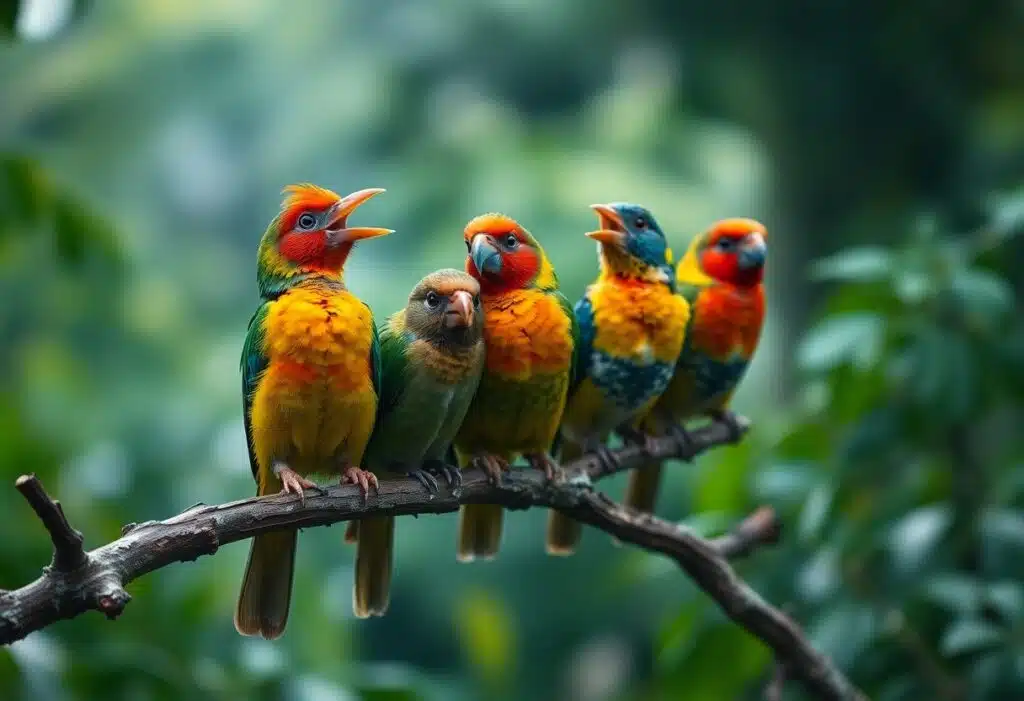Can Different Bird Species Communicate?
You might not realize it, but many bird species can communicate with each other in fascinating ways. By using unique alarm calls and contact calls, these feathered friends share important information about predators, food sources, and even when they are trying to attract mates. From the well-known chickadee to the savvy sparrow, you’ll find that different species of birds often understand one another’s messages, making their survival a community effort. Let’s explore how these remarkable interactions unfold in the avian world.
Key Takeaways:
- Communication through Alarm Calls: Many different bird species can send out alarm calls to warn each other about predators. This way, various birds can alert members of a mixed-species flock about nearby dangers.
- Learning to Understand: Birds do not just know what the calls from other species mean; they often learn to recognize these sounds over time. For example, chickadees and nuthatches understand each other’s alarm calls by listening and associating them with danger.
- Mimicking for Survival: Some birds, like the tufted titmouse, are not the only ones who communicate threats. They can trigger responses in nearby animals like squirrels, who learn to imitate these warning calls, creating a chorus of sounds that aid in survival.
In the fascinating world of birds, you’ve got species like the chickadee using their famous “chick-a-dee-dee” alarm call to warn others about nearby predators like owls and hawks. It’s a clever system where the number of “dees” can signal how dangerous the threat is. You might ask yourself, “Do different species of birds understand each other?” Well, according to research, they can! For instance, red-breasted nuthatches recognize the distress signals from chickadees and react to them. And it isn’t just birds talking to each other; they can involve other creatures too. If a tufted titmouse spots danger, they’ll sing their alarm call and cause nearby squirrels to dash for cover. It’s like a community alert system! So, the next time you stroll through a park, listen to those beautiful bird songs. There’s a lot more happening than you might think, and these amazing creatures are constantly communicating to survive and thrive in their habitats.
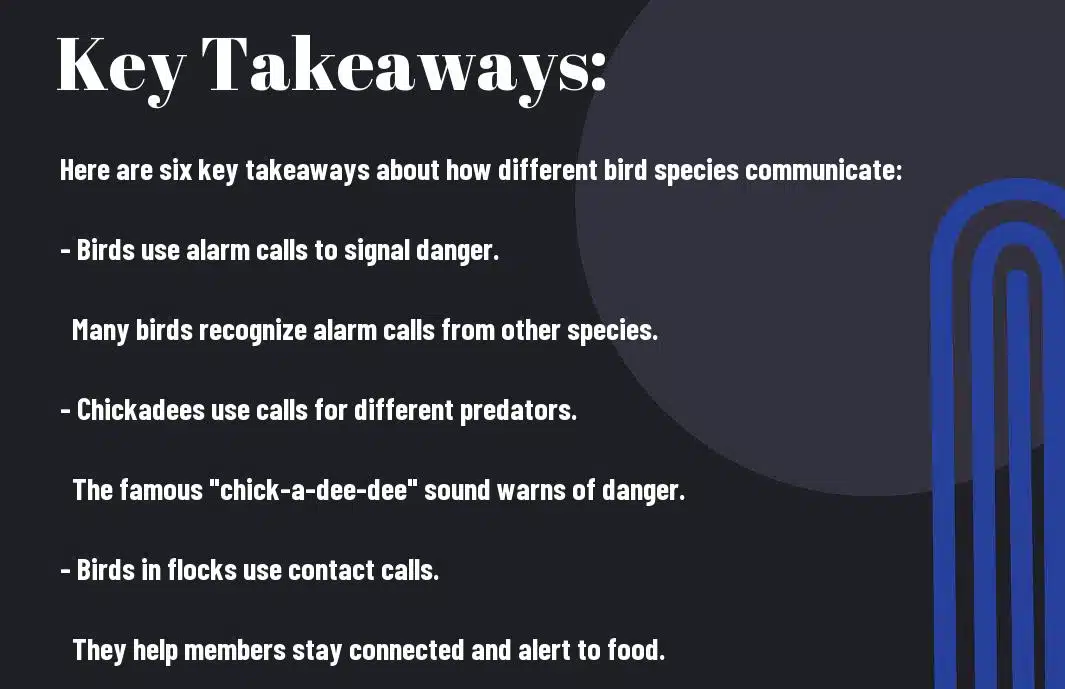
Understanding Bird Communication
While many people think birds simply chirp, their communication is rich and complex. Different bird species use unique vocalizations to express a variety of signals, whether it’s to attract a mate, warn of danger, or defend their territory. By learning to recognize these sounds, you can deepen your understanding of the avian world and how these creatures interact within their flocks and with each other.
Vocalizations and Alarm Calls
The sounds birds make go beyond mere tweets and chirps. They use alarm calls to warn each other of predators, like the black-capped chickadee, which has specific calls to indicate different levels of threat. By listening carefully, you can discern their alarm signals, enhancing your birding experience.
Interspecies Interaction
After observing their natural behavior, you may wonder if different species of birds can actually communicate. Some studies show that birds like red-breasted nuthatches understand the alarm calls of chickadees, helping them respond quickly to danger. This ability to recognize alarm calls can improve survival for many species.
It’s fascinating to note that birds can recognize alarm calls from other species, which is vital for survival. For instance, when a chickadee spots a raptor and calls out with a distinctive “chick-a-dee-dee”, other birds, such as nuthatches and jays, can understand and react appropriately. They might flee or become alert to potential danger. Learning also plays a role; some birds teach their young to recognize alarms from different species to enhance their safety. This interspecies communication is a wonderful example of how nature intertwines.
“Just about every bird species we have studied locally responds to other species’ alarm calls, and we suspect eavesdropping on other species’ calls is widespread around the globe.”
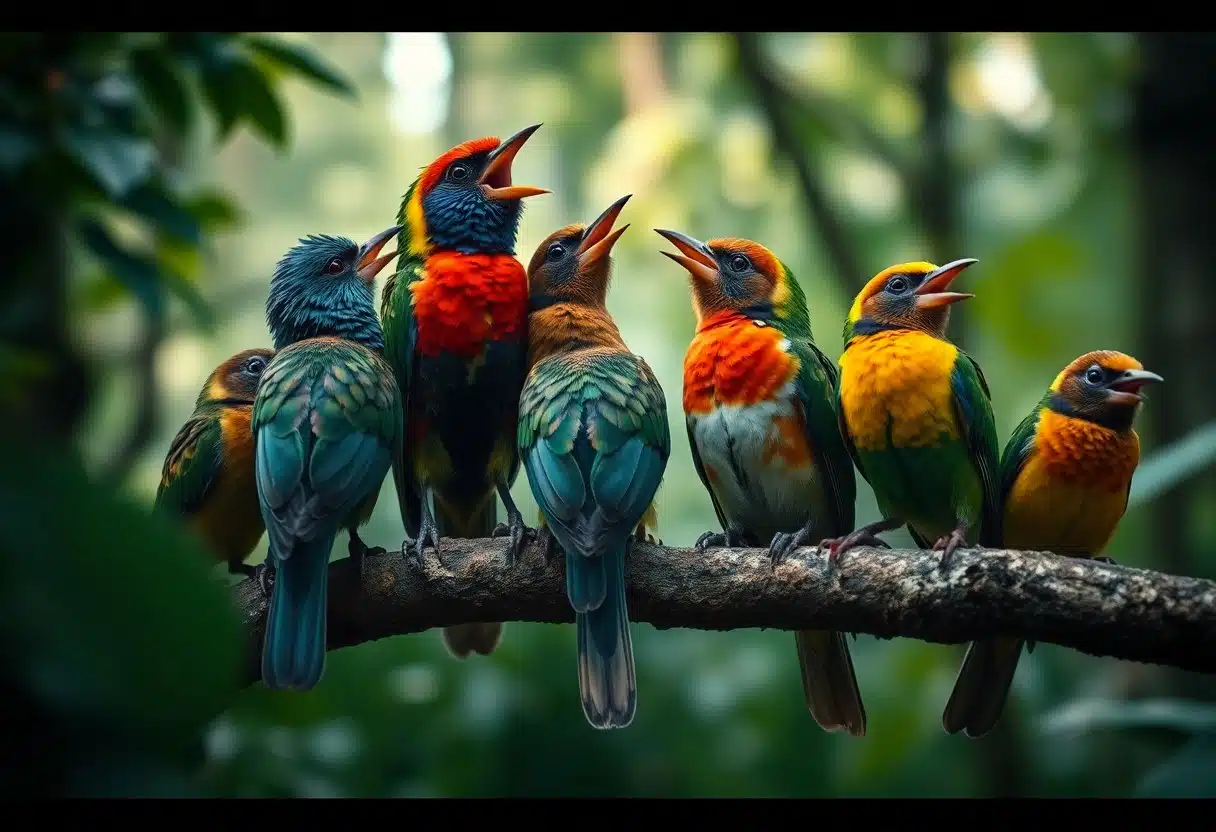
Examples of Interspecies Communication
Some birds engage in fascinating interspecies communication, using alarm calls to warn others about nearby predators. For instance, mixed-species flocks share contact calls to help each other locate food and stay together. You can learn a lot from just listening to their unique bird songs, which can provide insights into their survival strategies.
Case Study: Chickadees and Nuthatches
For example, black-capped chickadees use specific alarm calls to warn other birds like red-breasted nuthatches about different types of danger. Chickadees have a unique system of vocalizations, including the distinctive “chick-a-dee-dee” call, which varies in pitch and length based on the threat level. This allows nuthatches to accurately assess the risk and react accordingly.
Effects on Other Animals
Animals also benefit from bird communication, especially when it comes to danger. Birds, like the tufted titmouse, send out warning calls that not only alert other birds but also cause mammals, such as squirrels and chipmunks, to flee. This phenomenon highlights how various species work together to enhance their chances of survival.
Hence, when you hear a bird warning its flock about a predator, it doesn’t just help birds. It sends a signal to nearby mammals too. For instance, when the tufted titmouse calls out, it can make a squirrel bolt for cover. Even other members of species, such as sparrows and jays, have been known to imitate these alarm calls, creating an interspecies chorus. This cooperative communication model is necessary for survival in nature, demonstrating that many creatures can recognize warning sounds even if they’re from different birds. Being aware of these calls can help you better understand the animal world around you.
Learning and Adaptation in Bird Calls
After exploring the fascinating world of avian communication, you may find yourself wondering how different bird species learn to recognize and use various calls. If you’re curious about whether you can communicate with birds, check out Can You Communicate with Birds? | Ross Vet. Birds adapt their calls to enhance survival, using sounds to warn others of predators or attract mates, showing that their vocal skills are not just innate but often learned over time.
Observational Learning
About various birds, you will discover that they often learn by watching others. For instance, when a chickadee sees a hawk, it may watch how nearby nuthatches react to the alarm call. This helps them understand when threats are near, proving that birds can indeed learn from their surroundings and the calls of different species.
Experimentation with Novel Sounds
Experimentation plays a key role in how birds recognize alarms from other species. In fact, studies have shown that birds, like the superb fairy-wrens, can learn to react to unfamiliar sounds by associating them with danger. For instance, when new alarm calls were paired with a model of a gliding hawk, these birds quickly learned to respond to the recording. This shows their ability to adapt and learn from their environment, ensuring a higher chance of survival.
The Role of Eavesdropping in Survival
To survive in the wild, birds often listen in on each other’s calls. This practice, known as eavesdropping, allows them to detect potential threats and respond quickly. When one bird species spots a predator and makes an alarm call, other nearby birds can take action, whether it’s to flee or hide. By sharing this vital information, they boost each other’s chances of survival and improve their ability to find food and mates.
Benefits for Different Species
Against common belief, eavesdropping isn’t just for the birds who make the calls. It offers significant benefits for different species as well. For instance, when black-capped chickadees sound their alarm calls, nearby red-breasted nuthatches can understand the specific danger levels. This means that even if they aren’t the ones making the call, they still gain important information that helps keep them safe.
Alarm Calls Across Ecosystems
By using alarm calls, various bird species enhance their survival across different ecosystems. For example, the tufted titmouse’s warning signals not only alert other birds but also send squirrels and chipmunks scrambling for cover. This shows the wider impact of these alarm calls, creating a chorus of warning that involves not just the birds, but also other animals in the area.
Further research indicates that alarm calls can trigger responses across an entire ecosystem. These calls help you notice how adaptable different species are when it comes to survival. For example, you’ll find that birds like sparrows and jays can even imitate alarm calls from other species, creating a wide array of responses to threats. And if the same alarm call from a noisy miner is played, only those familiar with that sound will react accordingly. So, the ability of different bird species to understand and react to alarm calls showcases how interconnected life is in your local environment.
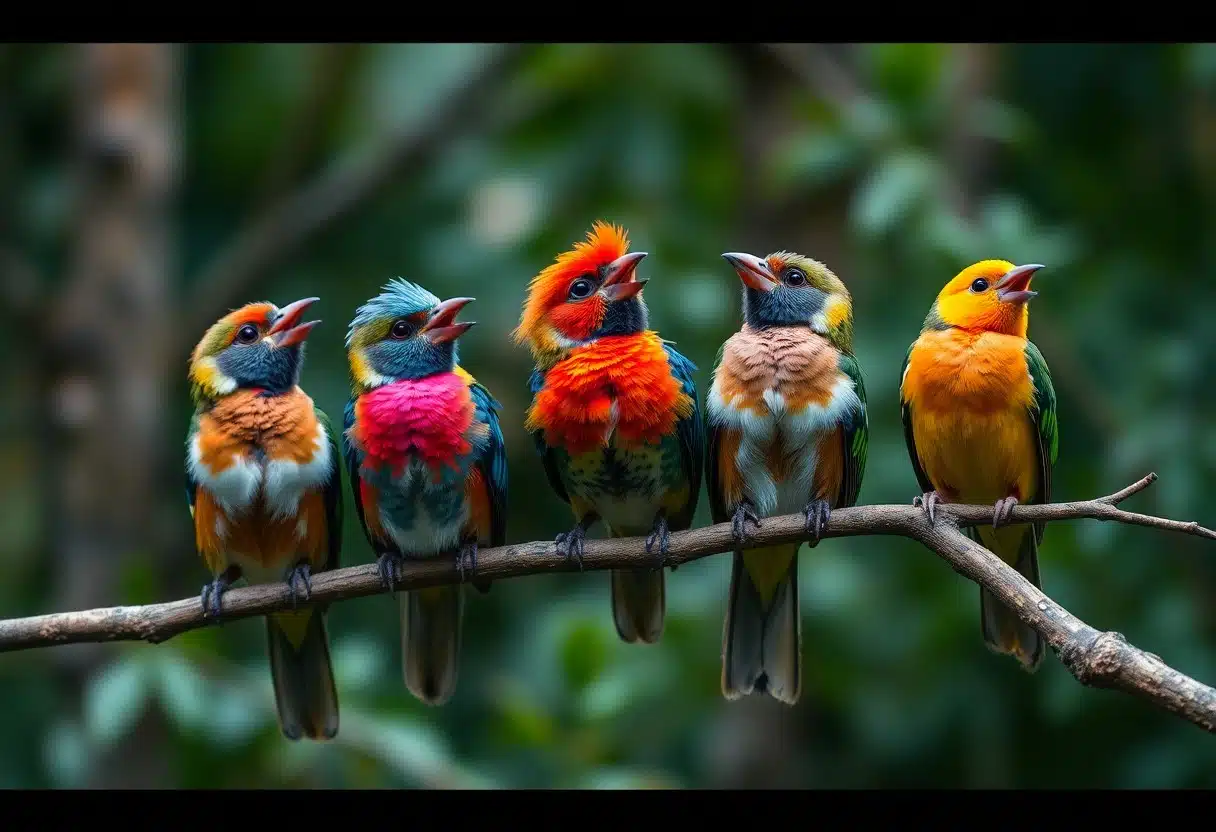
Implications for Bird Conservation
Now, understanding how different bird species communicate can greatly help in bird conservation efforts. When you learn how birds interact through alarm calls and songs, it highlights the importance of keeping their habitats protected. Preserving the environments where birds can hear and respond to these important calls ensures their survival and enhances their chances of thriving together.
Understanding Communication Needs
Needs vary among bird species, especially in how they use their vocalizations. You might be surprised to learn that many birds, like chickadees and nuthatches, not only communicate with their own species but also understand alarm calls from others. This indicates that various types of birds depend on these vocal cues to navigate their environment safely.
Addressing Habitat Preservation
About every bird’s habitat needs to provide a safe space for them to sing, call, and mate. Preserving bird habitats allows them to stay connected through their vocalizations. If their environment is disrupted, it may impact their ability to recognize alarm calls, locate food resources, and defend their territories, which can jeopardize their survival.
To help maintain a healthy ecosystem, your efforts in habitat preservation can make a big difference. You can support initiatives that ensure natural areas remain intact so that birds can listen to familiar sounds and warn each other about predators. For example, when birds like the chickadee sound their alarm calls, it’s crucial for survival. These alerts help them detect threats and stay safe. Remember that many species, such as squirrels and , also rely on these calls to navigate their surroundings. Protecting their habitats means you are helping not only the birds, but also preserving the delicate balance of nature.
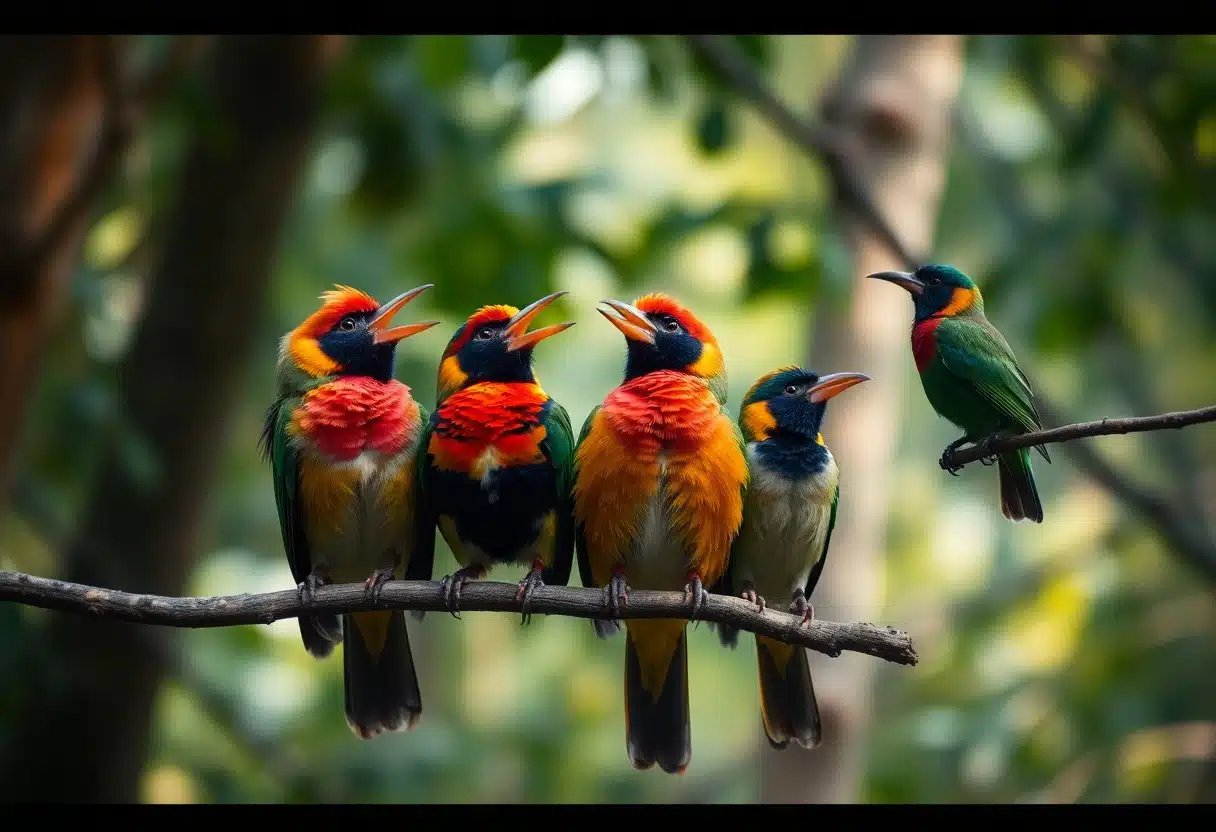
Future Research Directions
Many exciting questions remain about how different bird species communicate with each other. Future studies can dive deeper into how various species understand alarm calls and the complexity of their vocalizations. Moreover, researchers can explore how birds learn to recognize calls over time. By expanding our understanding, we can better appreciate the role sound plays in their survival and social interactions.
Expanding Study on Other Species
On the horizon, there’s a potential for studying even more bird species to see how they interact. Each group of birds has its own set of sounds, and investigating these can reveal patterns in communication. Understanding how different species, like sparrows or jays, recognize and respond to alarm calls could provide a broader view of their survival strategies.
Technological Advances in Bird Listening
Expanding technology has changed how you study bird communication. Modern devices let you capture and analyze various bird calls in nature. This helps in identifying different vocalizations, making it easier to recognize specific songs and alarms made by local species.
Even more fascinating, the use of advanced sound recording technology allows researchers to analyze vocalizations of birds in great detail. When you listen to the recordings, you can hear the variety of calls, including alarm calls like the chick-a-dee-dee or songs that attract mates. Understanding these sounds can show you how birds communicate about predators or find resources. They don’t just sing; these calls are key to their survival and interactions.
To wrap up
On the whole, different bird species can communicate effectively, especially through alarm calls and contact calls. You may have noticed how birds like chickadees and jays share warnings about predators. They learn to recognize and even mimic calls from other species, helping them survive and find food. Watching and listening to these interactions can be fascinating, showing you just how well birds understand one another. So next time you’re outside, take a moment to listen; you might hear a chorus of calls that tell a story of survival among different birds.
FAQ
Q: Can different bird species understand each other’s calls?
A: Yes, many bird species can understand alarm calls made by others. For example, red-breasted nuthatches can recognize the alarm calls of black-capped chickadees and react to different danger levels.
Q: How do birds learn to recognize calls from other species?
A: Birds learn to recognize calls by observing and listening to others. For instance, studies show that some species, like superb fairy-wrens, need to be exposed to alarm calls to understand them.
Q: Why is it helpful for birds to communicate with other species?
A: Interspecies communication helps birds survive. By listening to others’ calls, birds can detect nearby predators and find food sources, making it easier for them to stay safe and healthy.
As a bird enthusiast with a passion for sharing the wonders of our feathered friends. As a writer and nature lover, I'm thrilled to connect with fellow bird buffs and inspire others to take flight into the fascinating world of birds. Let's wing it together!

